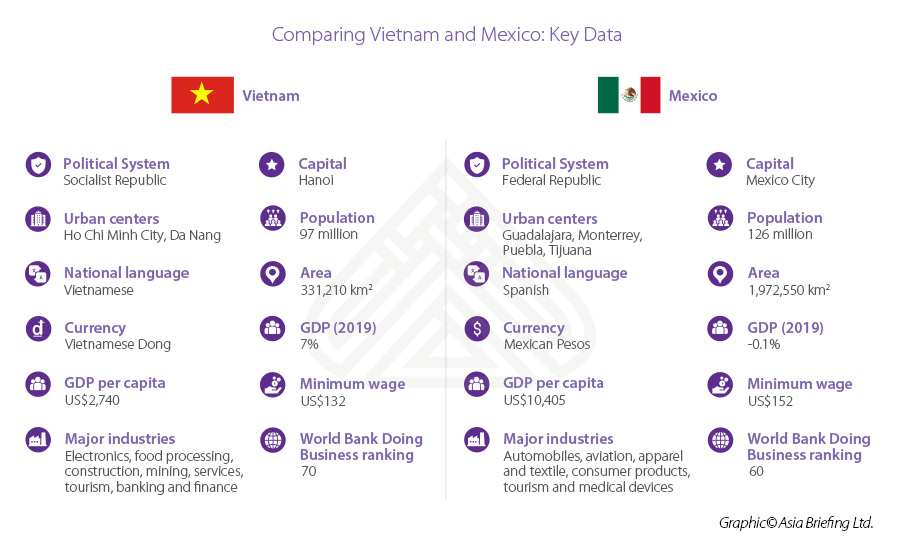Where Should US Businesses Look to Diversify Their China Operations: Mexico Versus Vietnam

The US-China trade war has forced firms worldwide to rethink business strategies, investment plans and operations, throwing a spanner in supply chain networks as well as expansion plans. For companies still on the fence, the COVID-19 pandemic has given further impetus to reconfigure and adjust their manufacturing operations.
Foreign companies outsourcing operations to reduce costs and improve market share is nothing new. The only things that seem to change are the companies changing the way that operations are relocated, and the countries that manage to attract capital inflows.
Instead of abandoning the Chinese market, investors are choosing to supplement Chinese operations with low-cost inputs sourced from production facilities in markets such as Vietnam and Mexico. While the structures of these operations differ greatly depending on the country in question, this production model has become widely known as China+1.
Navigating this geopolitical landscape can be difficult for most businesses but more so when moving business activity out of China.
Mexico and Vietnam, both feature high on the radar for US businesses choosing alternate sites due to their success and flexibility in creating an adaptable production base.
Both countries offer a suitable business environment. While most can appreciate China’s well-oiled supply chain network and business environment, both Mexico and Vietnam are making strides to bridge this gap.
To illustrate this, we can take an in-depth look at Mexico and Vietnam. Both countries have a different set of strengths, respectively, and multiple factors need to be accounted for when considering a manufacturing shift.
Investors should consider the following factors if planning to move operations to either of these potential candidates.
An introduction to Mexico
Mexico is the second-largest economy in Latin America. It has a current gross domestic product (GDP) of US$2.7 trillion and has been growing at an annual average of 2.6 percent for the past 20 years. Mexico has a large diverse economy that is linked to trade with the US. Mexico is an upper-middle-income G-20 and OECD member with a per capita GDP of US$10,405.
In 2018, Mexico was the third-largest trading partner with the US after Canada and China. Mexico is the first or second-largest export destination for 27 US states. Top US product exports include electronics, vehicles, fuels, minerals, plastics, and machinery. In addition, Mexico is the second-largest agricultural export market for the US and imported US$19.5 billion worth US agricultural products in 2018.
Mexico is also a member of the World Trade Organization (WTO) and has 13 free trade agreements (FTAs) that cover 50 countries, including the Comprehensive and Progressive Agreement for Trans-Pacific Partnership (CPTPP). Due to these FTAs, Mexico’s market is one of the most competitive and open in the world.
The advantages of investing in Mexico is that Mexican companies and suppliers are familiar with US products and services. US businesses typically find it straightforward to market their products in Mexico. Promising industries for US businesses in Mexico are agriculture, auto parts and services, aerospace, education services, energy, environment technology, information technology, transport infrastructure as well as tourism, among others.
Manufacturing
The above factors make Mexico a viable option for businesses looking to supplement or relocate their manufacturing options. Mexico offers similar labor rates as China’s and offers a highly-skilled workforce. Due to a diverse labor pool, companies from almost all industries can look to manufacture their product there.
Manufacturing in the country continues to grow and Mexico remains the 12th largest exporter in the world. Major manufacturing industries in Mexico include automobiles, aviation, apparel and textile, consumer products, and medical devices with raw materials coming from the US, China, Japan, Germany, and South Korea among others.
Mexico is also attracting large and multinational manufacturers from all industries. The country has become the fourth largest automobile producer in the world. While Mexico still relies on the US and China for inputs, its supply chain is well established. Given the high concentration of manufacturing operations in several industries, businesses can make use of established infrastructure and supply chain networks.
—————————
This article is produced by Vietnam Briefing, a premium source of information for investors looking to set up and conduct business in Vietnam. The site is a publishing arm of Dezan Shira & Associates, a leading foreign investment consultancy in Asiawith over 27 years of experience assisting businesses with market entry, site selection, legal, tax, accounting, HR and payroll services throughout the region.
- Where Should US Businesses Look to Diversify Their China Operations: Mexico Versus Vietnam
- Contact us

